A Magic: The Gathering Creature Review by Jonathan Wojcik
By October of 1997, I'd been a Magic: The Gathering fan for five years of my young life, which to a teenager feels like forever. Now it's almost been that long since I started these reviews. I hate time.
Despite being wildly into the game, though, young teenage me had a hard time finding a lot of really interesting creature cards to call favorites. The Krovikan Horror, the Urborg Mindsucker and various Thallids were almost all I had in my collection that really wowed me in terms of creature design, with the game still dominated largely by more conventional dragons, undead, giant animals and goblinoids.
What really excited me back then, though, was a special set of cards belonging to a brand new creature type, exclusive to the plane of Rath and supposedly created by Volrath himself...
The Metallic Sliver

Illustrator: L.A. Williams
Though this particular specimen is an artificial imitation of a sliver, I think it's the best one to start out with, because it plainly illustrates the novel anatomy of these things. The typical sliver has an eyeless, bony, swept-back head with a simple beak for a mouth, a single bony talon in the middle of its chest, and two prehensile "tails" it can slither around on.
It's a very simple set of features, but an unforgettably unique combination. Nothing either in nature nor in popular culture looks anything at all like a sliver, but something about this anatomical plan still feels extremely believable, like some phylum of our own animal kingdom that simply never was. Needless to say, kid-me was head over heels for these things. I thought that this body plan was hands-down the single coolest possible creature I had ever, ever seen in the whole wide world. I practically wanted to BE a sliver back then, and I never thought it possible that I might even get tired of their aesthetic.
...Which I did, but that doesn't mean they don't still have a special little place in my nostalgia, and we still haven't gotten into what really sets them apart as a concept.
The Winged Sliver
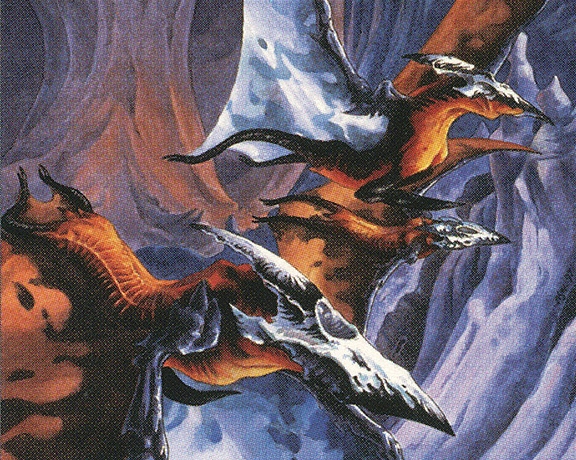
Illustrator: Anthony S. Waters
So let's take a look at all of the original Rath Cycle sliver cards, by color, and let's start with one of the most basic, the winged sliver. "Flying" is pretty much the simplest and most iconic creature ability in the game, and simple means that the creature can only be blocked by other flying creatures. Give a sliver wings, and it kind of looks a little more mundane, doesn't it? Just a slightly odd pterosaur, really, though I honestly kinda like how they have more of a long, tubular body and shorter little tentacle-legs.
Here's the thing, though: the winged sliver doesn't just have flying. Its card reads "all slivers have flying." That means that when you put the winged sliver down on the table, every single other sliver you have out is now also able to fly, and any new sliver you play is also going to be able to fly, for as long as your winged sliver is alive and well.
This is the unique twist to this creature type. All slivers in play automatically share all of their abilities, always, and as you can imagine, this can start to get pretty bonkers.
The Mnemonic Sliver
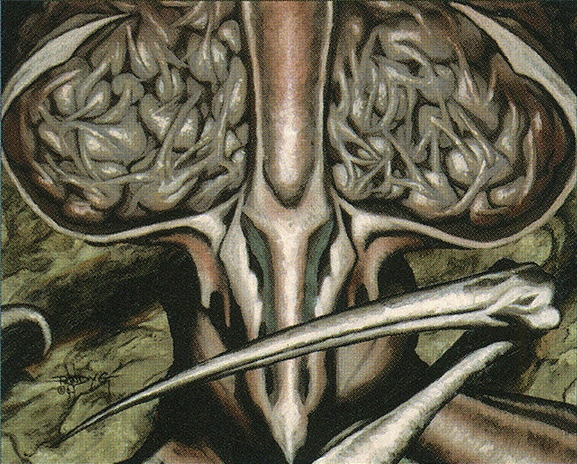
Illustrator: Randy Gallegos
Blue mana is a color associated with water, air, and the mind, so it makes sense that one of the original two blue slivers would be a flyer, and the other a brainiac. Mnemonic Sliver allows all slivers to sacrifice themselves, at a cost of two mana each, for you to draw an extra card. Given that you normally get only one new card per turn, extra draws are a pretty hot commodity in this game.
I really like the look of that strange tissue in this sliver's massive, open skull sockets. Is that a brain, or some other network of tissues and glands?
The Talon Sliver
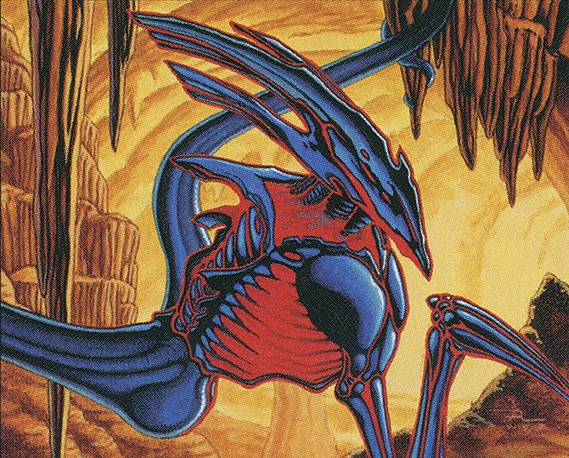
Illustrator: Mike Raabe
This white-mana sliver grants the "first strike" ability to all slivers, meaning that they deal damage to an enemy creature first, and then only receive damage in turn if that creature survives.
The intense coloration of this sliver is interesting, like it glows an intense red from the inside, though there isn't a whole lot of emphasis on its actual talon, which doesn't look a whole lot different from the talon of any other sliver. Kind of a missed opportunity.
The Armor Sliver
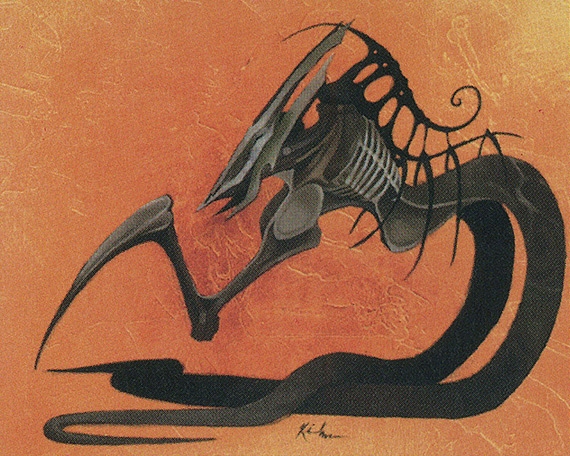
Illustrator: Scott Kirschner
White's less common sliver allows all slivers to temporarily gain an extra point of toughness if you spend an extra two mana on them that turn. Nothing too special, but it's a beautiful looking sliver by one of my favorite artists in the game. It doesn't look particularly "armored," except for that lovely black outgrowth down its back and partially encircling it in a sort of external, secondary set of ribs. Is that the "armor?" It's pretty damn cool looking if it is.
The Clot Sliver
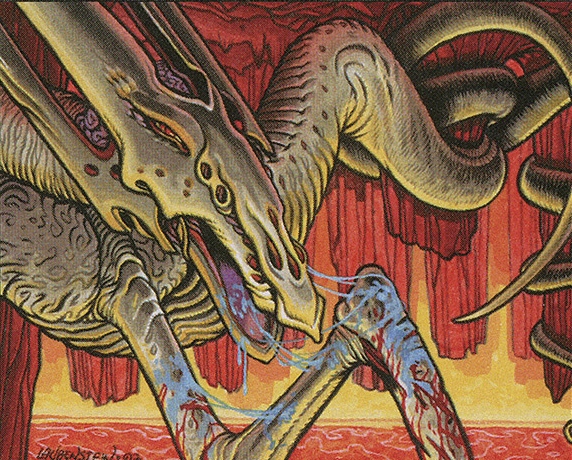
Illustrator: Jeff Laubenstein
The common black sliver of the original set is appropriately grotesque, with an exposed pink brain, rugose flesh and copious amounts of drool. It's actually one of the few slivers we ever see with its mouth open, and it's also one of the few with eyes!
This sliver allows any other sliver to regenerate from death at the cost of two mana.
The Mindwhip Sliver
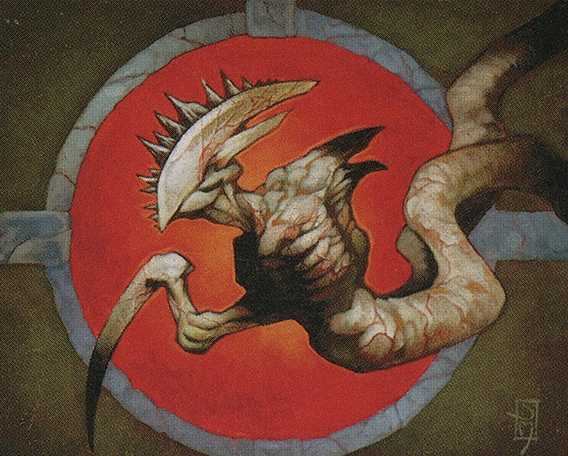
Illustrator: Jeff Miracola
The opposite of the Mnemonic Sliver, Minwhip allows you to pay two mana and sacrifice a sliver to force another player to discard a card. I'm not sure exactly what this means for the sliver itself, but it seems to have a cool mohawk of black blades.
The coloring and texturing of this sliver also looks remarkably like the visual style of Silent Hill, which would come out a couple of years later.
The Muscle Sliver
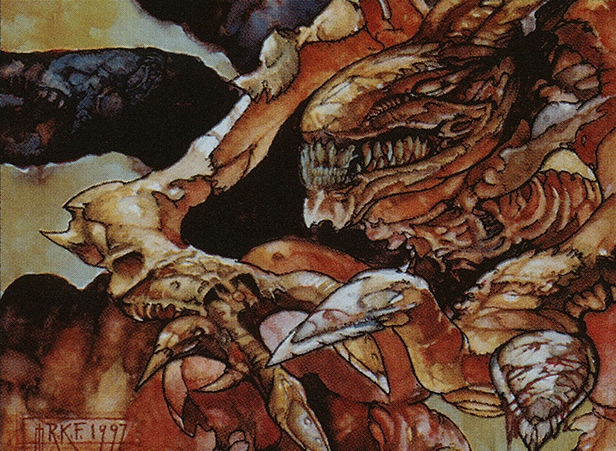
Illustrator: Richard Kane Ferguson
The most essential sliver back in the day was a green-mana common that simply gives all slivers +1+1. Get four of them out (the limit to duplicate cards in the same deck) and every sliver gets a minimum 5/5 in stats.
You will notice this sliver is wildly different from the others, too. It has more of a straight Giger Alien face, complete with teeth, no visible talon, and a pair of humanoid arms with two oversized fingers each.
The Horned Sliver
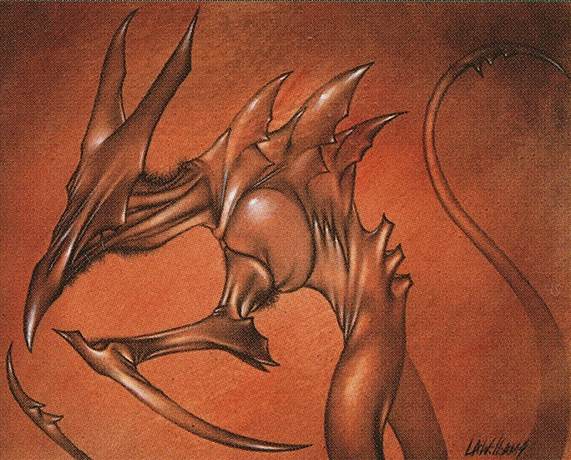
Illustrator: L.A. Williams
The less common, 2/2 green sliver is another by the Metallic Sliver's illustrator, as well the artist behind the Dauthi Mindripper up there, and gives all slivers the trample ability, meaning that if their attack stat exceeds the toughness of a creature blocking them, the opponent will take the difference in damage.
Every wrinkle, muscle and bladed edge on this sliver is painted so lovingly, so elegantly, and with more of that fine fuzz Williams puts on some monsters. I like that big, solid ball of flesh at the base of the taloned arm, for some reason. A nice central point to the image.
The Heart Sliver
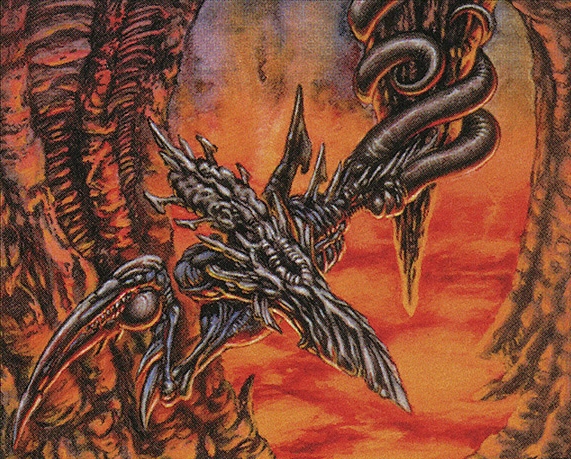
Illustrator: Ron Spencer
Spencer is a natural for the slivers, and goes on to be perhaps their single most important artist. This common red sliver has all the slimy, meaty goodness we come to expect from him, looking almost like a shriveled up "heart" itself. This sliver gives all slivers haste, meaning they are allowed to attack the same turn they've been played.
The Barbed Sliver

Illustrator: Scott Kirschner
And here, we have both the first sliver card I ever saw and what remains my favorite. There's just something about that pale, stylized antelope-looking skull and finely thorny tails that I really love, although it took me a long time to realize its body was supposed to be foreshortened by the angle. I previously interpreted the Barbed Sliver as actually having a much blunter body than other slivers, dominated by a larger head, and I still think that's the cooler interpretation.
Barbed Sliver is just like the armor sliver, but pumps up attack instead of defense!
The Acidic Sliver
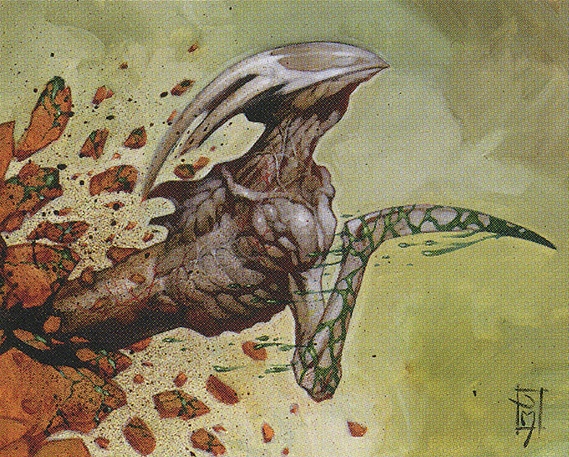
Illustrator: Jeff Miracola
We now come to the rare slivers added one set later, each of which is a gold card combining two different mana colors. Acidic Sliver is black and red, and allows any sliver to be sacrificed for any two mana to deal two damage to any enemy creature or player.
A very simplistic sliver design itself, but also an exceptionally phallic image of one. Right? It's not just me???
The Victual Sliver
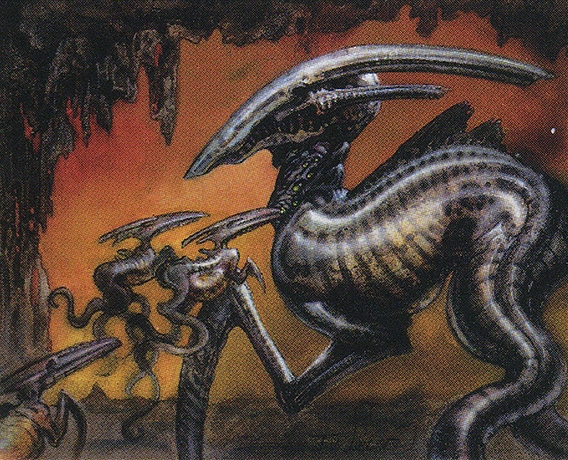
Illustrator: Terese Nielsen
This one allows you to pay two mana and sacrifice a sliver to gain four life, which is a pretty reasonable amount of life to get all at once. I guess it's a sliver that produces some kind of life-sustaining nutrient fluid, as evidenced by the adorable baby slivers nursing off its neck-pores.
Beautiful slivers, too, with their bones showing through that slick, transparent skin!
The Hibernation Sliver
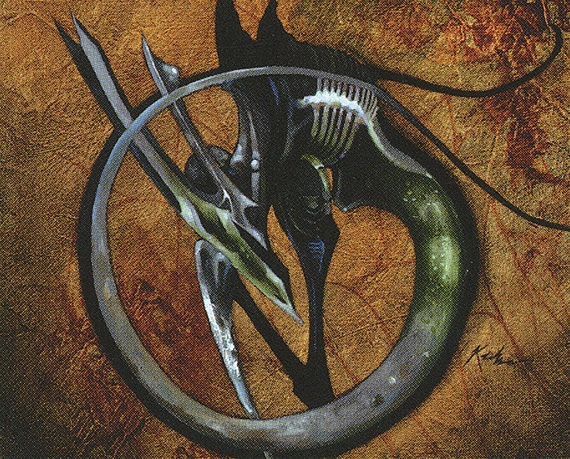
Illustrator: Scott Kirschner
This blue and black sliver allows you to pay two life to return any sliver back to your hand, in case you want that sliver to avoid upcoming disaster or rid itself of pesky enemy enchantments. Not much to say about the illustration; typical of Kirschner's slivers with that lovely visible rib cage.
The Crystalline Sliver

Illustrator: L.A. Williams
Our last one by Williams, a lovely transparent specimen whose crystalline body apparently protects it from being specifically targeted by any spells or abilities, a pretty valuable addition to your swarm! When creatures in magic have this particular trait, though, they can still be affected by abilities that have no single target, like if you've got a spell that just says "destroy all creatures." So, you can't aim a death ray as a crystalline sliver, but you can still catch it in a nuclear blast.
The Spined Sliver
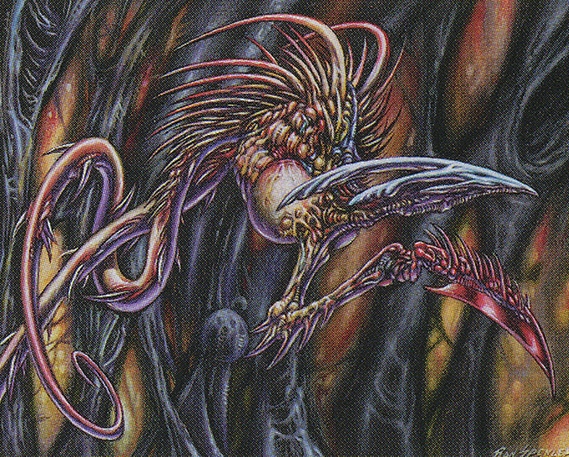
Illustrator: Ron Spencer
Another really cool one from Spencer! He's always the guy to go to when you want a thorny, spiky monster, and this sliver's bristling back doesn't disappoint, with the mix of meaty colors Ron is also well known for.
This one ensures all slivers gain +1+1 for each creature that blocks them in combat! This is the last of the original slivers that grant abilities, and if you somehow managed to get one of each sliver in play that we've now reviewed, every single one of them would be able to fly, strike first, attack immediately, hibernate on command, heal their controller, explode into acid, sprout barbs, sprout armor, sprout quills, recall spells, force somebody else to forget their spells, evade magical attacks, bulldoze over smaller enemies, and of course, they'd all be just a little musclier.
The Sliver Queen
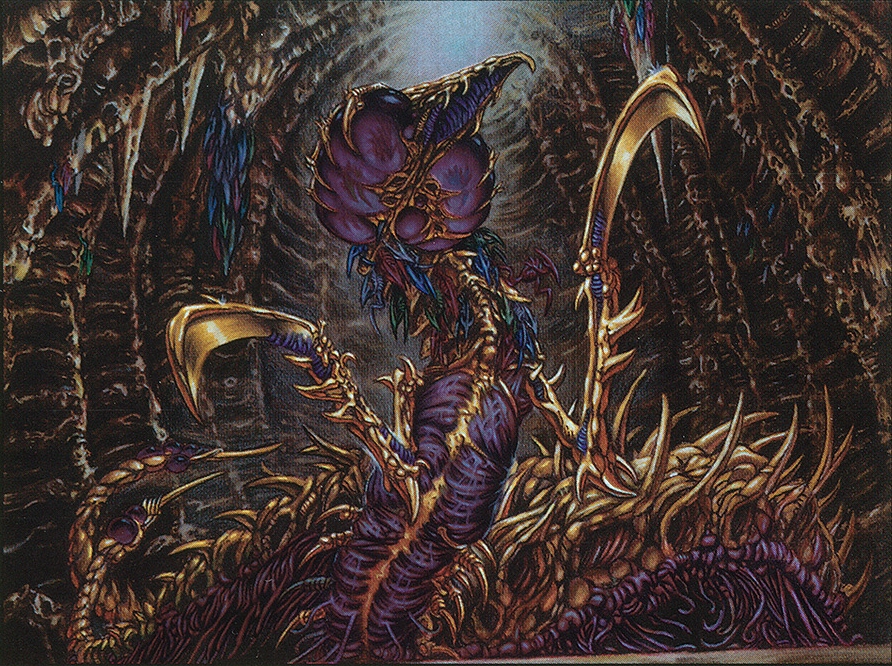
Illustrator: Ron Spencer
And now, the holy grail of Sliverdom, and a card I only got my hands on when my parents got me an entire box of card packs for Christmas that year, yielding one and only one copy of a sliver queen.
So, let's talk about that design. Sliver Queen has TWO taloned arms, which technically makes her look more ordinary and less alien than her babies, but I love the combination of bony yellow chitin and juicy purple flesh, with swollen cheek sacs that apparently brood her young and dozens of little slivers creeping down her body! I also really like that we can see more slivers roosting in clumps on the cavern ceiling. They sleep together like BANANAS!
Sliver Queen costs one of every color of mana for a 7/7 creature, and for two mana of any color, she can generate a 1/1 sliver token.
There's even a lovely little story moment involving the queen. One of the main characters of the Weatherlight saga is Karn, the silver golem, part of "The Legacy" of magical artifacts that include the Weatherlight airship itself. Most of these artifacts come to be stolen by Volrath and protected by the sliver hive, but the queen allows Karn to retrieve them when he explains that they're an extended part of himself - just like her and her children.
If you've read my introductory page to these reviews...then you know that, unfortunately, I lost my sliver queen along with all of my other cards, I still don't know how, I still don't know where, and it is most likely that they wound up in somebody's garbage.
But for a good few years, Sliver Queen was the pride of my collection, and the envy of the few other human beings I ever got to play against. I remember people fawning over the card at a comic store I visited, asking me if they could even just hold her for a moment, because unusually for anything I happened to like, slivers were a massive hit with everybody back in the day, and are still a celebrated cornerstone of the game's world building.
It was inevitable, then, that the slivers would be resurrected, both in our world and in theirs...
THE SECOND WAVE
The third and final set in the original Rath Cycle indicated that the slivers were actually wiped out when Volrath transported his entire plane into one of the game's other settings, Urborg, and accidentally dumped the entire sliver hive into the heart of a volcano. This was a plot point so lousy I seem to have expunged it from my memory until re-reading about it just now, but not to worry!
Five years after the Rath Cycle, or a few hundred years later in-universe, some fool octopus people called the Cephalids would discover the fossilized remnants of the original slivers and go full Jurassic Park on their discovery, with results as disastrous as you can imagine. Thus ushered in a whole new generation of sliver subspecies, which we're going to review here as thoroughly as Wave One!
The Mistform Sliver

Illustrator: Ben Thompson
We started with blue last time, so we'll do it again. Mistform sliver allows all slivers to become an additional creature type, for one turn, at the cost of any one mana. Useful if you have cards that affect other types! Flavor text reads "Taking the form of a junior researcher, the first sliver slipped out of Riptide."...so I guess the mistform was the one that actually escaped the labs.
It's a nice looking sliver. Appropriately pale for a "misty" being, with an interestingly large armored plate right at the base of its neck and some sort of prominent sensory pits on its skull.
The Shifting Sliver
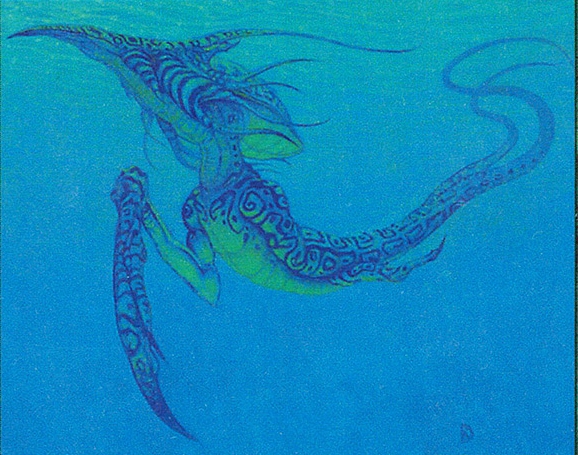
Illustrator: Darrell Riche
Nice to see some slivers operating underwater, where I'd say their body plan looks more at home than anywhere else. This sliver renders all slivers completely unblockable, except by other slivers, which is really kind of outrageous. Unless your opponent has slivers, which usually aren't worth having unless your ENTIRE deck is slivers, they have no means whatsoever to fight back as your own slivers tear apart their health count, turn after turn.
It's a neat looking one, too, covered in elaborate stripes and spirals with an array of different cranial whiskers. We're also seeing a bizarrely humanoid torso, with only the right arm as the sliver's talon, so I think the idea here is that this sliver is mid-way between some sort of mimicry, possibly from the guise of a mer-person. It's the sliver version of a mimic octopus!
The Synapse Sliver
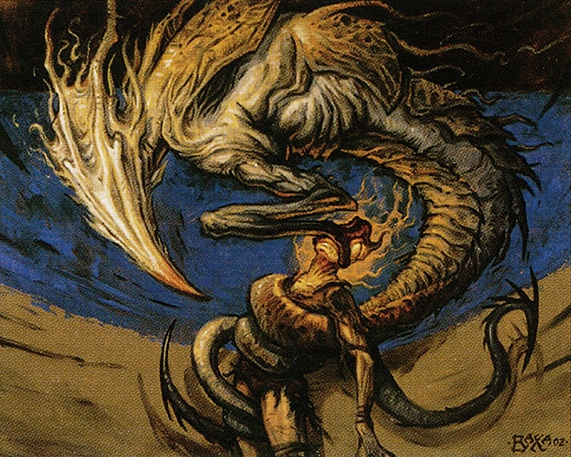
Illustrator: Thomas M. Baxa
This wave also introduces the first rare slivers other than the sliver queen, giving each color a single common, uncommon, and rare variety. Blue mana's rare sliver allows you to draw an extra card every time one of your slivers damages another player, and has a nicely frightening, buzzardy sort of look to it. Most interestingly, it swaps the usual single blade-arm for a boneless looking "hand" that appears to drain brainpower!
This card's flavor text also includes a "research note" that I wish we had on other slivers:
"Species XR17 feeds upon the mental energies of its victims. This explains why the goblins remain unaffected. - Riptide project researcher"
Hardy har, cheap joke, but still, I'd love to have seen these little scientific explanations on more of these.
The Plated Sliver
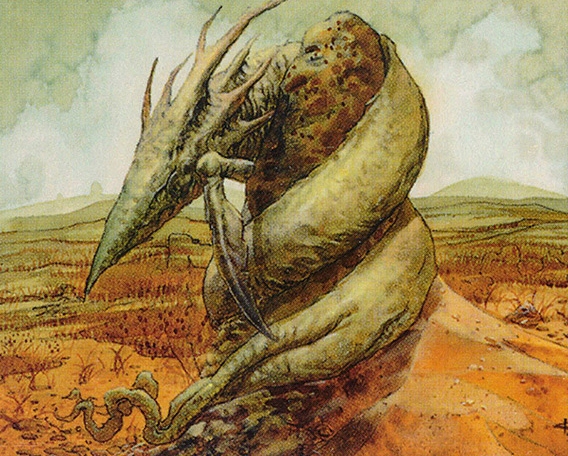
Illustrator: Greg Staples
This simple 1/1 sliver for one white mana simply gives all slivers one additional point of toughness (health) or +0/+1. A very pretty illustration, too; I like seeing the slivers coiling and slithering around like big worms, and the woody branch-like look of Greg's sliver skulls is pretty cool. The only problem is that this sliver doesn't look obviously "plated." If anything, it's as un-plated as slivers ever get!
The Ward Sliver
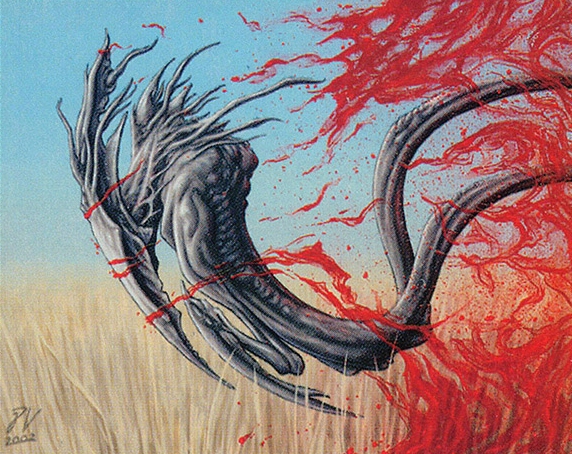
Illustrator: Pete Venters
A nice, sinewy looking sliver by Venters, in a cool action pose as it bursts through some kind of misty, red barrier. When you play the Ward Sliver, you get to choose any color of magic, and all slivers become immune to spells, abilities and damage from that color. You can only have four of the same card in a magic deck, so you can only have enough ward slivers to protect against four of the five colors, but that's still pretty good! Especially if you're only playing against one or two people, since people seldom use more than a couple of colors per deck.
The Essence Sliver

Illustrator: Glen Angus
The rare white-mana sliver ensures that every time a sliver inflicts damage, its owner gains an equivalent amount of extra life! Really lovely looking sliver, too, I like the longer, bent neck and how zig-zaggedy the whole thing is.
The Crypt Sliver
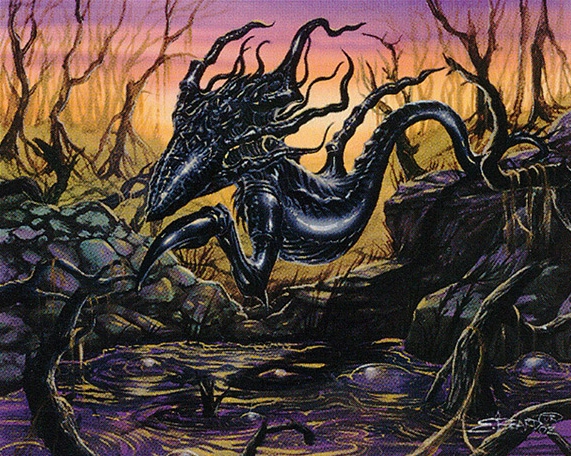
Illustrator: Edward P. Beard Jr.
An inky, slinky black-mana sliver that allows every sliver the power to tap (expend their single per-turn action) and regenerate any other sliver that would otherwise die. I always liked how the regenerate mechanic, despite its healing connotations, is most common among black cards to represent "undeath."
Not an especially remarkable sliver, however. A very cool image, artistically, but we're definitely well beyond a point at which the basic sliver anatomy isn't all that special anymore, as cool and distinct as it may be.
The Spectral Sliver

Illustrator: Pete Venters
I most recognize Venters for the gnarly, wrinkly flesh and bone he's so good at painting, but this foggy phantom sliver is really beautiful as it slinks through the swamp. It allows any sliver to gain an extra +1/+1 for one turn at the cost of two mana, because being able to spontaneously "grow" like that is another mechanic associated with a lot of black cards, and especially the traditional power of "shades" and other ghostly entities.
The Toxin Sliver
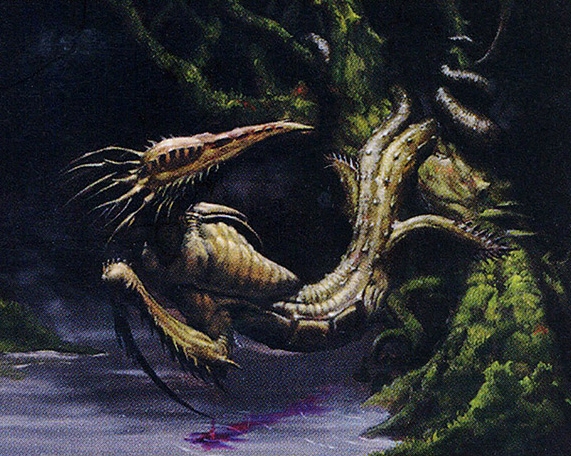
Illustrator: Lars Grant-West
With the toxin sliver in play, every sliver becomes so venomous that it automatically kills any creature it damages, no matter their relative stats, and the victim can't even regenerate if it has that ability!
I like this one's design, too. Not terribly different from other slivers, but definitely really cool with all those little extra barbs and twig-like growths, not to mention the two thorny paddle-like appendages it has in addition to its coiling tails.
The Hunter Sliver
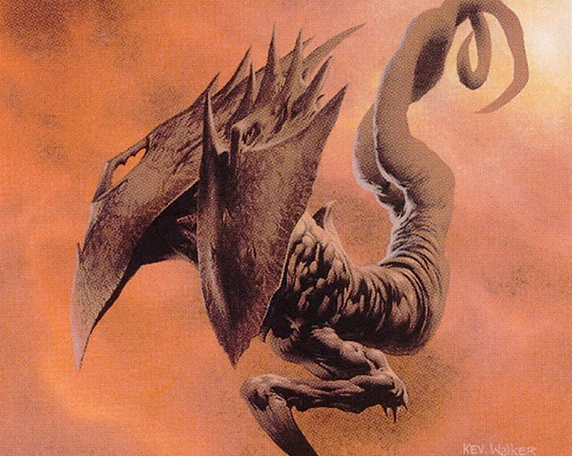
Illustrator: Kev Walker
The ability provided by this sliver is that when any sliver attacks, its owner can force any enemy creature to block that sliver. This is handy as a way of killing creatures your opponent might be using for their abilities rather than their combat stats, which is a lot of creatures. Pretty much all decks are going to have purely supportive creatures in them.
Not much to say about the design, though. It just has two heads. When I was a kid, I didn't think I could ever get enough of slivers.
The Blade Sliver

Illustrator: David Martin
Fortunately, some slivers still deviate a little more from their basic template. Even if it didn't have an extra limb, I really like the hairy chitinousness of this sliver, like a solifugid or something. it also, interestingly, has a pair of additional short tentacles or fins mid-way down its body and a longer, more winding tail. Does it have only one tail? We can't see if it branches like the usual.
This one is the red-mana counterpart to the plated sliver, boosting all slivers by just one power (attack point).
The Magma Sliver
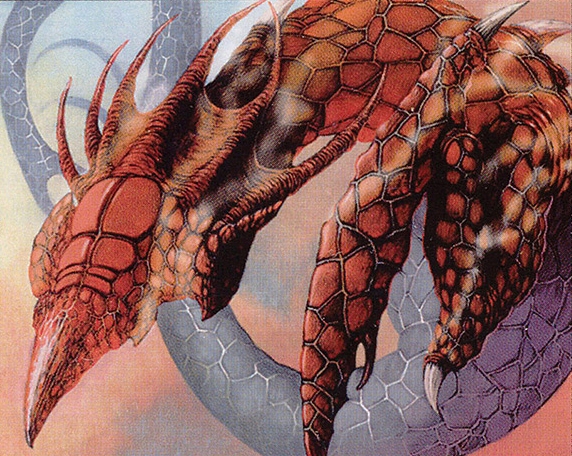
Illustrator: Wayne England
The rare red-mana sliver has a pretty formidable ability. As long as it's in play, any sliver may tap itself to boost the attack stat of any other sliver until the end of the turn, and by one point for every single sliver in play!
So, if you've got ten slivers out, you can tap one to give any other sliver a +10 boost to the damage it can inflict. You could tap half of them to give the other half a total of 50 extra power! More than twice the amount of health a player even starts with!
The imagery is about what we expect from any magma-themed monster, though, which is why I've never been a big fan of magma critters. There's only so many times a cracked, hot red surface is all that impressive on a monster... I say as I conceive my 500th Mortasheen covered in slime.
The Quick Sliver

Illustrator: John Avon
This sliver allows you to play sliver cards at any time you could play an "instant" card, which means you can lay new slivers down in the middle of battle or after other abilities and effects have already passed.
It's another pretty ordinary sliver, though. I feel bad saying this because every one of these are painted beautifully, and I do love Quick Sliver's translucent blade and exceptionally prickly head, but by this point, a sliver's a sliver, and they kind of need something extra to stand out.
The Root Sliver

Illustrator: Matt Thompson
Root Sliver ensures that sliver cards can never be "countered," a game mechanic that allows some cards to simply cancel other spells and send them straight into the trash. If you're not a player, it's probably important to mention here that all creature cards are considered a type of spell, since you're magically "summoning" that creature into battle.
An alright looking sliver for what it is, too. A nice pulpy, woody specimen with even some extra branches off its tail than the usual single split.
The Brood Sliver
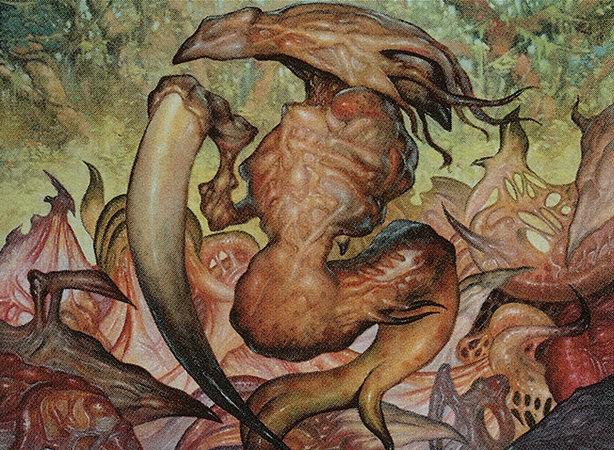
Illustrator: Ron Spears
Uh-oh! A major plot point of the sliver rebirth is that the Riptide scientists never recovered any samples of the sliver queen, and even when their creations escapes their control, they shouldn't have been able to reproduce! According to the Brood sliver's flavor text, though, it took only weeks for their new population to exceed all the slivers to ever exist on the plane of Rath.
Brood sliver makes it so you get a new, baby 1/1 colorless sliver token any time any sliver damages any player, which is going to be pretty often once you've got slivers that can fly and camouflage and spit poison and a million other things at once.
I like the look of this one, too. I like the more knobbly bird-beak head, the twisting wormy cranial tendrils, the gangly arm with an absurdly huge claw and the tail that's more like a bent, multi-toed leg. It all just looks even better in Ron Spears fleshy, oily style, and whatever the heck is going on in the background is pretty interesting as well. It looks like some kind of chaotic mess of tissue in the process of forming many, many more slivers.
The Sliver Overlord
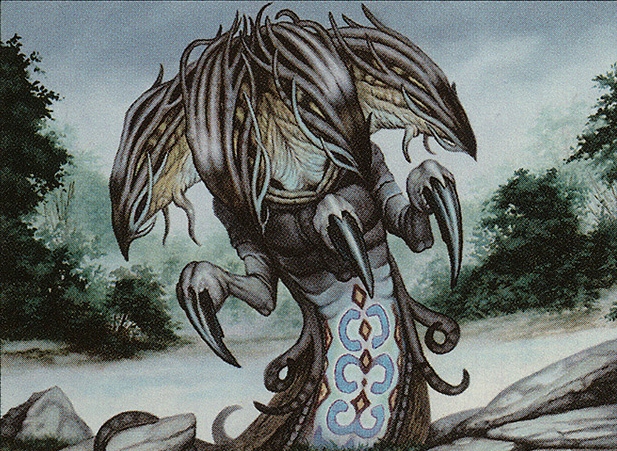
Illustrator: Tony Szczudlo
Though lacking a queen, the new slivers eventually produce an equivalent in this five-color "legendary sliver mutant," which has the ability to search your deck for any sliver you want and put it into your hand, or even gain control of any enemy sliver.
Unfortunately, I'm kind of neutral on this design concept. I really love the colorful belly patterns, which look believably like some kind of natural threat display, but otherwise, we've just got another sliver with additional heads and limbs.
EVEN MORE SLIVERS
Since their in-universe reawakening, slivers have resurfaced for one reason or another in various sets and settings roughly every two to six years, and by now, there are almost a hundred different slivers in the game. If you're playing a format that allows any set ever released, the options to customize your swarm are downright limitless. Players could use nothing but sliver decks and still probably hatch thousands of different strategies.
But, we are not going to review a hundred different creatures on just this page. My opinions on slivers are already getting a little repetitive, and so are their designs and abilities, so let's just review my top favorites, in no particular order, from the year 2006 to 2015....
The Shadow Sliver
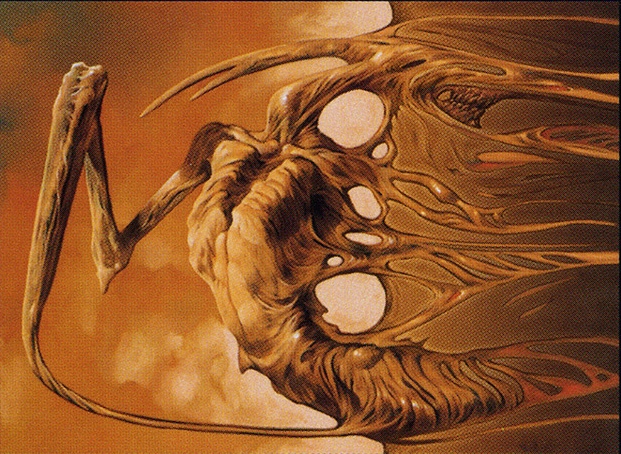
Illustrator: Warren Mahy
This blue-mana sliver appears in "Time Spiral," a set involving time-space distortion and callbacks to the entire history of the game, which added a whole 26 new slivers. This one grants all slivers the "shadow" ability, which was once exclusive to the same "Rath" setting as the original slivers, but was never before accessible to them under natural circumstances.
The concept of "shadow" is that a creature is trapped between planes of reality, and can only interact with other "shadow" creatures. So, shadow creatures can only block or be blocked by other shadow creatures. I like that this is not only a callback to Rath, but even fits in perfectly with Time Spiral's story.
The design of this sliver is killer, too. It's not just the fact that we're seeing it seeping out of another dimension like an oil slick, but it gets a ghoulish set of teeth, corpse-like skin and a talon where a humanoid arm would be. A gruesome looking creature, especially for a blue card.
The Spinneret Sliver

Illustrator: Michael Sutfin
This green sliver allows all slivers to block flying creatures, even if they don't themselves have the flying ability. It's an unnecessary trait if you're able to use winged slivers anyway, but it's interesting because it's an ability normally given to all spiders in the game, representing their ability to spin a web! So, we get a sliver with ten additional spidery limbs surrounding a silk gland that appears to be on its back, given that the usual taloned arm appears to be on the other side of its body.
The Telekinetic Sliver

Illustrator: Randy Elliot
This blue sliver allows any sliver to tap itself and simultaneously tap any other card anyone else has in play, locking down that card's ability to fight or activate any other abilities until the next turn. So, to illustrate its telekinesis, this sliver just has a great big ol' visible pink brain, always a good addition to just about any monster. Its upper chest also gives me an eerily horse-like impression, and I like how long and whiplike its body gets before it finally forks.
The Dementia Sliver
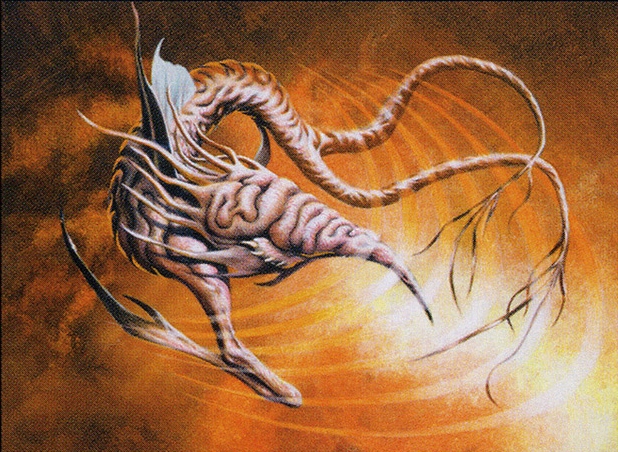
Illustrator: Una Fricker
I think this black and blue mana sliver might have my second favorite design of the entire type. Just the way it's modeled entirely like brain tissue, with its tail branching into veiny nerves, looks SO nice to me, as does the entire overall shape of it; the head is just big enough, the body just fat and wormy enough, it's pretty much my perfect sliver.
Dementia sliver's ability is a little complicated and unreliable, but can probably be a real pain if you have a lot of slivers in play. It allows you to name any card, tap one of your slivers, and pick a random card from your opponent's hand. If it's the one you named, they have to get rid of it!
The Pulmonic Sliver
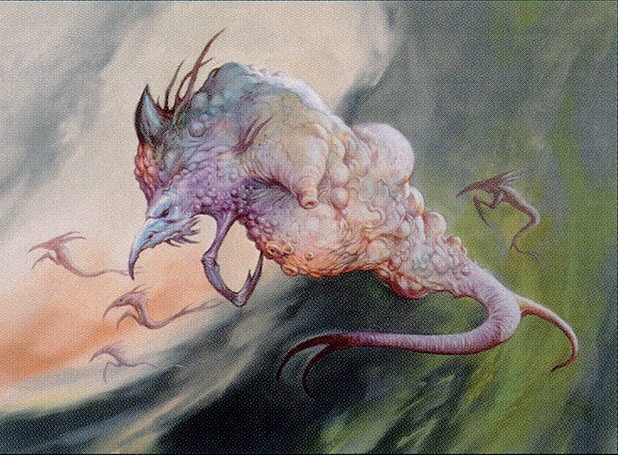
Illustrator: Jeff Easley
This card, meanwhile, has my ACTUAL new favorite design of the bunch. Just look at this horrible thing's bloated, baggy cyst of a body! Look at its grumpy little vulture face! I can't believe such a ghastly looking sliver is a white card, which allows you to put dead slivers back onto your deck instead in your graveyard.
This really illustrates how fun and divergent a sliver can be, and it's a shame that they're otherwise so samey. Look at any large enough group of real animals and you'll see pretty startling variation on the same basic model, sometimes even more extreme than the difference between this and your archetypical sliver.
The Plague Sliver
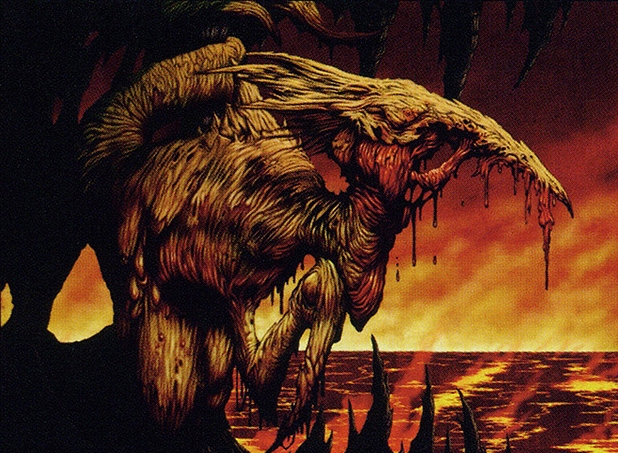
Illustrator: Dave Allsop
This black sliver's ability causes all slivers to do a single damage to their own controller every single turn, including itself, so you actually don't want this sliver in your own swarm at all, but you can use it to punish some other sliver-happy player, suffering only one damage from its noxious germs while they might lose all the health they have left in just a turn.
A beautifully grody sliver, too. The fine, crackled wrinkliness of it and the fading from red to yellow nicely communicates its diseased quality!
Venser's Sliver
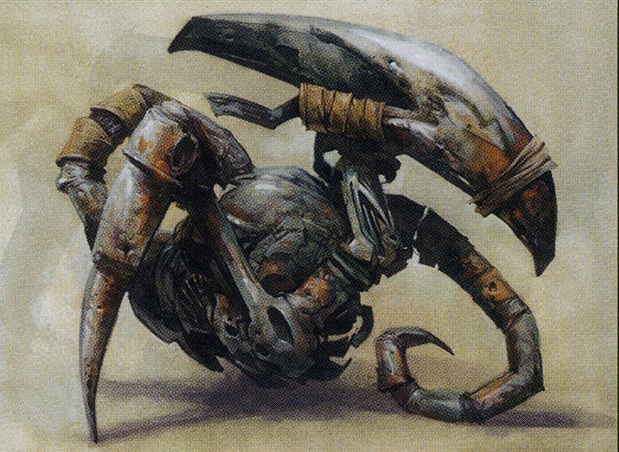
Illustrator: Carl Critchlow
This is the second-ever artifact sliver in the game, having no abilities but adopting any provided by other slivers. I just like it because it looks so junky and patched together, even though "Venser," judging by other cards, is supposed to be a pretty serious and skilled inventor.
The Poultice Sliver
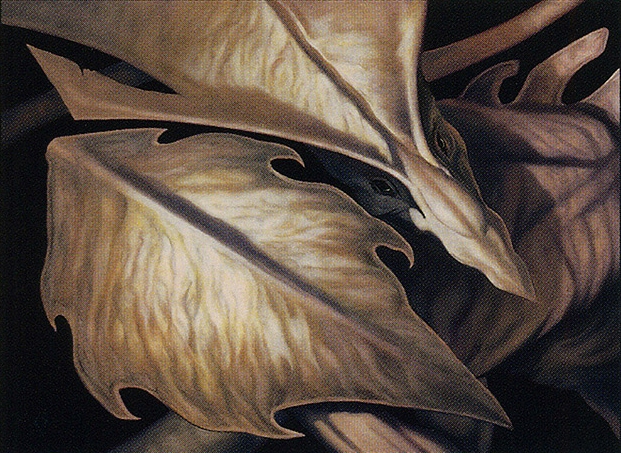
Illustrator: Randy Gallegos
Here's another that changes up the basic design to a satisfying degree, and only by flaring out its head and talon into a pair of impressive shields! This is also possibly the cutest sliver, not only a rare example of a sliver with obvious eyes but a downright sweet and gentle look in them, which suits this sliver well; a white creature that allows any sliver to tap and regenerate any other sliver.
The Spitting Sliver
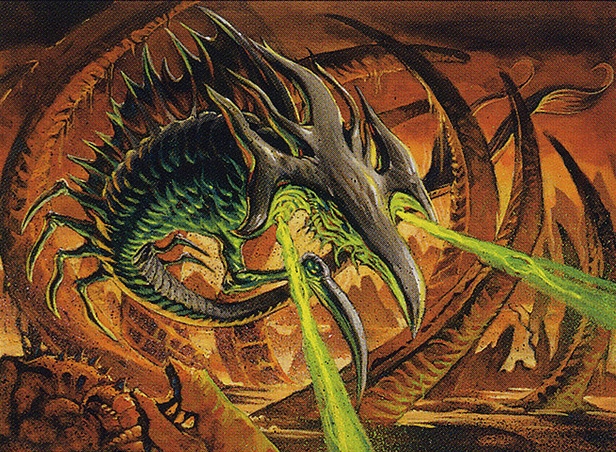
Illustrator: Steve Ellis
Like the white-mana "Talon Sliver" of their original run, this sliver simply grants the "First Strike" ability, but this time, it's a black creature and it has a pair of acid cannons in its face, so we all know which of the two I prefer. I like the fishy back fin and little buggy legs of this one, too.
The Darkheart Sliver
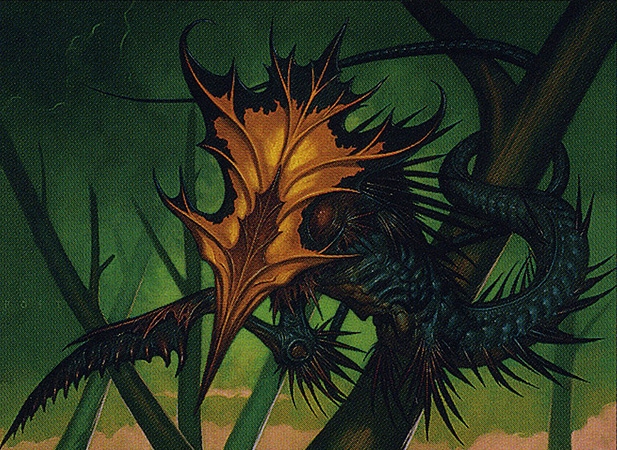
Illustrator: Rk Post
This is a black and green card allowing any sliver to sacrifice itself and give its creator an additional 3 life. While still following the typical sliver layout, its gigeresque exoskeleton, copious spines, leaf-like head and stunning color scheme make it another of my personal favorites, and I even love the visual painted by its flavor text:
"At first we thought we were in some haunted wood. Then the branches twisted and scuttled toward us."
The thought of these beautiful things in such dense numbers that they might be mistaken for a forest canopy is just plain wicked!
The Frenzy Sliver
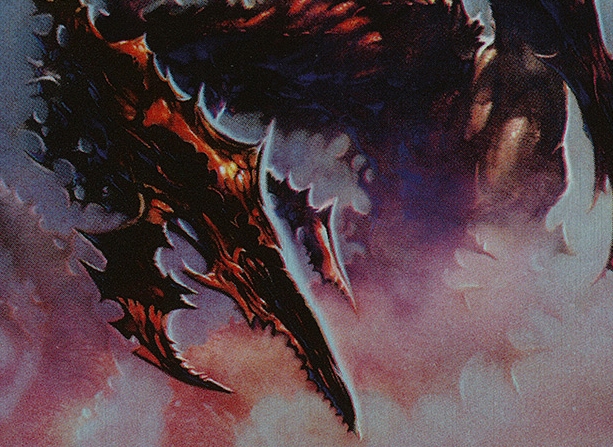
Illustrator: Glenn Angus
This black sliver causes all slivers to gain a temporary, extra point of attack if they don't get blocked by an enemy creature, and it's not my usual style, but I like how sharp and jagged it is from beak to tail, almost like it was very roughly carved out of a big lump of obsidian. This is a sliver that will give you an absolutely bad time.
The Lymph Sliver

Illustrator: Ittoku
This white sliver reduces any damage to any sliver by 1 point per damage source, and apparently that's because it makes them all sticky and slimy and semi-fluid all over. I am really liking how "gross" the white-mana slivers can get; all healing and protective effects shouldn't automatically be clean and pretty!
That stickiness is very well illustrated, too, with a pale pink and purple color scheme to really push that visceral, biological feel. I like the view we get of this sliver's mouth and chin, too. It's another that feels almost like a wildly distorted horse.
The Virulent Sliver
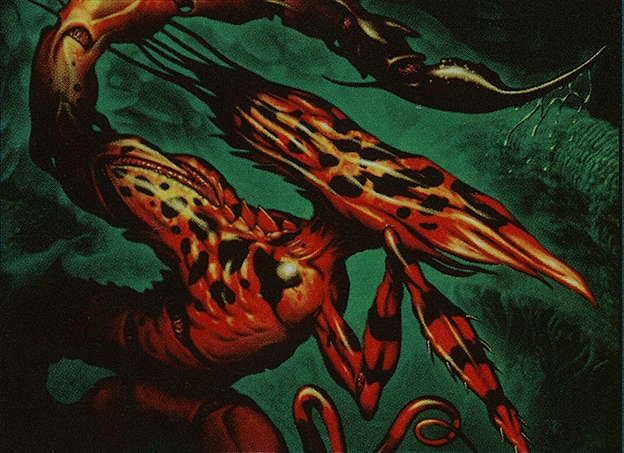
Illustrator: Franz Vohwinkel
By this point in the game, there actually aren't too many conventional slivers at all! Almost every sliver in "Future Sight," such as this and our last three, tries to visually set itself apart from the rest. This sliver makes all slivers poisonous, so when they damage any player, that player gets a "poison counter." This is a rare but very nasty mechanic in the game, as ten poison counters will kill a player no matter how much life they have, and very few cards can actually remove these counters.
I love the exotic color pattern of this sliver, the little barbs on its spade-shaped talon, and of course the fact that it has a huge scorpion-like stinger on its back, distinct from any of its usual appendages!
The Sliver Legion
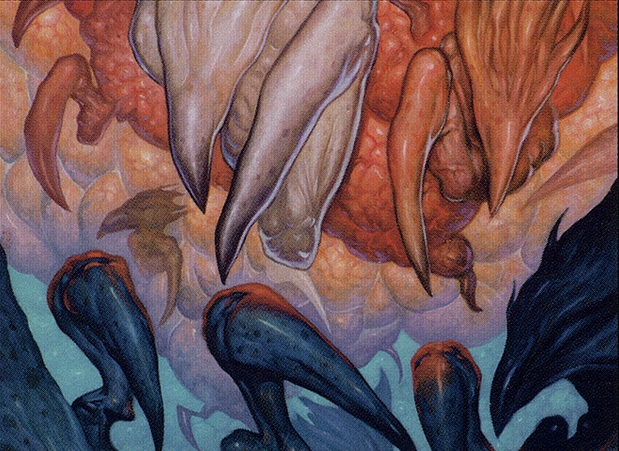
Illustrator: Ron Spears
Having said all that about exotic forms, I like the simplicity the slivers return to here, even if they also seem to be melding together into one big, giant, pulsating Sliver-Tetsuo! This is the game's third five-color, 7/7 legendary sliver, and this one gives every sliver +1/+1 for every other sliver in play, meaning that if you have ten slivers, every single one of them gets +9/+9!
I write these articles assuming a lot of people reading them might not even be familiar with this game, and if that's you, I'm wondering how well I might have communicated so far that slivers can get VERY out of hand, very fast, and you'd better have a pretty mighty defense against them, or one of the game's various (expensive) spells that just nuke everything at once. No wonder the original Rath cycle not only introduced the slivers, but a hefty black spell called "Extinction," that just wiped out any single creature type of your choosing.
THE MAGIC 2014 SLIVERS
So, here's where things take a temporary nosedive. I apparently wasn't the only one who thought the basic sliver body template was getting a bit old...
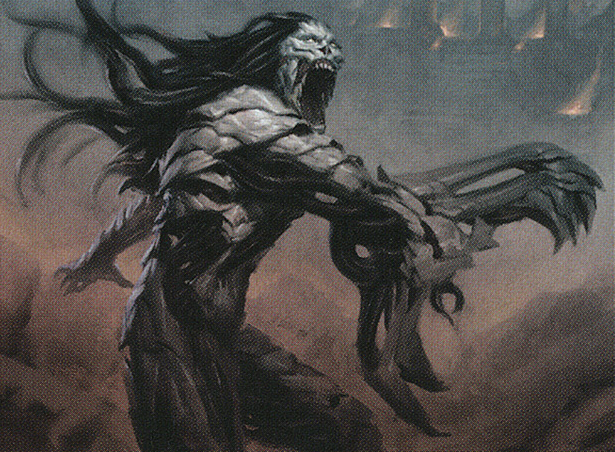
Syphon Sliver Tyler Jacobson
...But was this really their best answer to that problem?
Yes, for real, this cheesy-looking Dethklok groupie is somehow supposed to be a sliver, and quite typical of the slivers introduced in the 2014 set, nearly all of which are humanoids or at least quadrupedal, with similarly over the top Todd Mcfarlane Zombie faces and tentacle dredlocks, without even the subtlest of callbacks to their evolutionary roots.
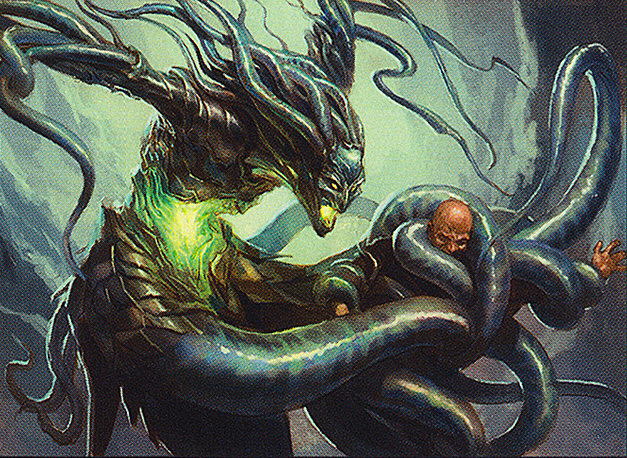
Constricting Sliver by Karl Kopinski
Needless to say, fans of the species were not amused, and following a tidal wave of backlash, Wizards of the Coast promised to never, ever mess with slivers again...which...kind of makes me sad, actually.

Leeching Sliver by Svetlin Velinov
As demonstrated best by this bloodsucker, these new slivers were supposed to be colonies of smaller, more worm-like slivers linked together within larger suits of biological armor, and that's actually a pretty rad direction for the slivers to go. It's really too bad if they've been spooked away from this idea for good, because it could easily look cooler, more alien, and even terrifying with the right execution, and would have less reason than ever to stick with one repetitive body type. I'd actually rather see this concept retooled and better polished than abandoned entirely, or at least some other effort to mix slivers up. There's really nothing wrong with experimental reimaginings like this; if they fail, they fail! It's no big deal!
And at least not all of them looked like cybernetic Juggalos...
The Sliver Hivelord

Illustrator: Aleksi Briclot
Our very last sliver, for now, is also the fourth five-color legendary and most powerful of the new-style slivers, whose ability simply renders all slivers completely indestructible. Yikes! More importantly, it actually looks like a sliver, without looking EXACTLY like a sliver, and apparently still consists of multiple "worms" in an exoskeleton. See? It wouldn't have been that hard to give these slivers more exotic shapes!
I don't know what the future will hold for these critters, but I'm hoping when they make their inevitable return, they might still show a little more diversity than they have in the past.
After all...both a turkey and a stegosaurus are still birds. There's always a way to keep slivers, or any other creature concept, fresh and interesting without completely scrapping what originally made them special!




